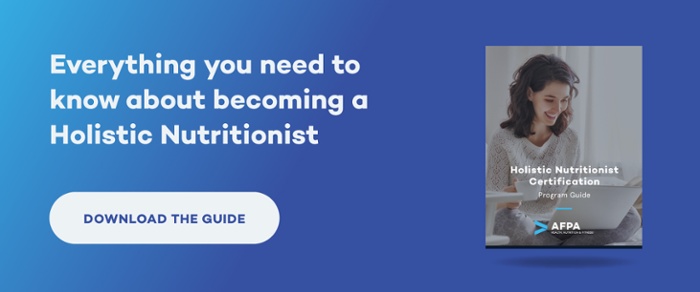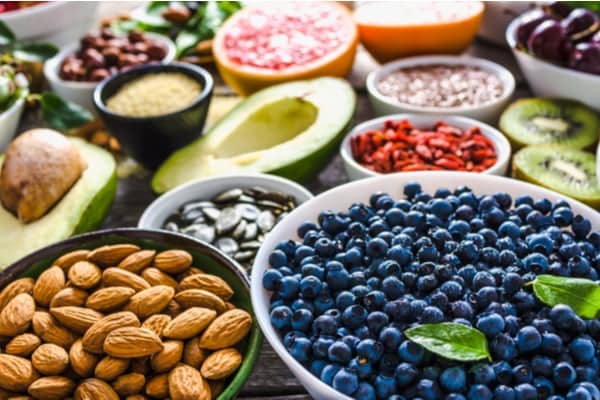Many health and nutrition coaches have strong opinions about the nutrition facts label on foods; some coaches find them to be great tools for consumers, while others feel that they are confusing for the general population.
While the US nutrition facts label has undergone many revisions over the past several decades to make it easier to understand and to better inform people’s food choices, research shows that there is still plenty of room for improvement in how nutrition information is presented.
As a health and nutrition coach, you have an important role in helping your clients feel empowered to make choices that improve their health and wellbeing. Part of that is helping them to navigate the food landscape and use public health tools like nutrition facts to understand what they are eating.
Here, we offer a 4-step method to explaining nutrition facts to your clients and some things to keep in mind.
Become a Certified Holistic Nutritionist Online in 6 Months or Less
Guiding Principles for Making the Most of the Nutrition Facts Label
Nutrition facts labels can be a powerful tool for helping people understand how what they eat contributes to how they feel and to their health status. However, it can also be easy to give too much power to the nutrition facts label if we aren’t aware of its imperfections and potential impact on our clients’ relationship with food. To help with this, we’ve included three guiding principles.
Remember that Nutrition Facts Are a Tool
Before looking at the numbers and the nutrients, it is important to remember that nutrition facts exist not to villainize or elevate foods but as a tool to help you understand the nutritional content of foods. Some of the key messages of nutrition facts labels include:
- Which of the main categories of nutrients a food contains. The decision about which nutrients to display takes into account those that have been identified to be lacking from the diet of people in the US, or those that potentially have the greatest impact on human health.
- For each serving, how much of a nutrient the food provides to your body, relative to the average needs of someone that requires 2,000 calories a day.
- How many servings each package provides.
At the same time, it is important to remember that nutrition facts do not display all of the information about a food’s nutritional content. For example, components that contribute to human health, like some antioxidant compounds, are not quantified or listed. Additionally, some foods may contribute significant amounts of certain vitamins or minerals that are not required to be listed.
You Don’t Always Need to Check Nutrition Facts
There is plenty to be said about how diet culture has created the need to control, calorie by calorie, what goes into our body. Public health tools like the nutrition facts label were created to empower individuals, rather than the food industry, in making food choices.
Diet culture can transform tools of empowerment into elements that lead us to obsess over calorie counting and nutrient counting. While there may be situations where calorie and macronutrient counting are beneficial to individuals, such as for dietary therapies for disease or to reach fitness goals, research shows that nutrient counting behaviors in the general population are associated with eating disorders.
As you work with your clients to understand nutrition facts labels, remind them that the labels are there as a tool to help them understand how a food fits into their overall diet, but that food is much more than the nutrients they contain. Food, in addition to fueling our bodies and minds, is something to be enjoyed for its emotional and cultural value.
Ultimately, the goal of working with your clients to read the nutrition facts label is to help them have confidence in understanding key messages without having a compulsive need to do so with every food.
The Food Industry Plays a Role in Developing Dietary Rules and Recommendations
Nutrition and health coaches have the general understanding that the food industry plays a role in generating expectations and desires around food through marketing tactics and messaging. Some tactics include connecting foods and drinks to emotions, experiences, or even achieving a certain physique.
However, the food industry’s influence doesn’t end there. Together with nutrition, epidemiology, and public health experts, the food industry also has an influence on nationwide dietary recommendations. This is because, unlike other countries where the health and welfare departments take the lead with dietary recommendations, in the US, the USDA is responsible for dietary recommendations. The USDA primarily represents agricultural interests, so, logically, the industry will have a say in what is recommended.
Other ways the food industry influences guidelines is through funding research that is of interest to them and through direct lobbying when public health regulations and laws that might affect their industry are in play.
One example of how food industries have influenced public health guidelines is the dairy recommendation. We know that dairy is not a “necessary” food group; in other words, it isn’t needed to sustain life. However, it remains a recommended food group because of political pressure by the dairy industry representatives.
With regard to the nutrition facts label, you’ll notice that labels now need to have the line “added sugars” under total carbohydrates. This is because added sugars have long been known to be the culprit of many health issues rooted in nutrition, including type 2 diabetes. However, it took almost 17 years since the petition was made to actually make the change. Even then, “added sugars” is still listed as grams, even though the recommendation limits are in teaspoons. It’s unclear what caused the delay, but it is plausible that the food industry had a hand in challenging evidence.
These principles are important to keep in mind so that we remember that the nutrition facts label is an imperfect tool as we work with clients to use it to their advantage.
4 Steps to Understanding Nutrition Facts
The FDA has developed a 4-step process to reading and understanding the nutrition facts label.
Serving information
At the very top of the label, you will see how many servings are in a container and the size of a serving, usually represented in cups or tablespoons (volume) and weight. For most people, it’s easier and more practical to estimate a serving with the volume of kitchen measurement tools than by weight.
Servings are most relevant to the nutrition facts label because the nutrient information is based on the per-serving information.
In other words, if a container of yogurt contains two servings, but you eat the entire container, you’ve consumed double the nutrients it reports on the label.
Expert tip: Sometimes, food companies will list that one package of a certain food contains more than one serving, but the package doesn’t allow for easy resealing, or the quality of the food or drink will decline after the package has been opened. The food packaging design makes it so that the consumer eats the packaged content all at once, but listing two or more servings allows the food company to display lower daily values on the package. This is common in sugar-sweetened foods and beverages, like sodas and packaged pastries.
Calories
Calories are perhaps the most famous element of the nutrition facts label. Calories are a measure of energy that a food provides, and in the context of the nutrition facts label, it reports how many calories a food provides per serving.
There is no need to be scared of calories! All living beings need calories to survive and thrive.
Knowing how many calories a food has gives little information about the nutritional quality of a food. Modern Western society has encouraged us to look for “low-calorie” foods and shun “high-calorie” foods with little consideration for nutrient makeup.
In short, knowing the number of calories in a serving is most useful when also considering the nutrients a food provides. Nutrient-dense foods are those that contribute a significant amount of a variety of nutrients for the calories. Some examples include a vegetable lasagna, a caprese salad, or natural almond butter. Nutrient-poor foods, popularly called “junk foods,” are those that contain lots of energy from one or two macronutrients but provide little to no other nutrients.
Nutrients
The nutrients included in the nutrients facts label are those that the FDA deems to have the most impact on your health.
In general, public health experts make the following recommendations when it comes to nutrients:
Nutrients to get less of: saturated fat, sodium, and added sugars. These are the nutrients that research has shown to be most associated with chronic disease development. They also tend to be nutrients that are abundant in the Western diet.
Nutrients to get more of: Dietary fiber, vitamin D, calcium, iron, and potassium. These are nutrients that have added benefits when you consume more of them. Additionally, when your diet is lacking in these nutrients, it results in significant negative effects on your health.
Keep in mind that you can use the label to meet individual needs. Your client’s diet may be lacking in unsaturated fats or protein, or they may benefit from identifying foods with B12, so you can guide them toward this area of the label.
Bonus tip: The FDA has developed an interactive tool to explore and understand the nutrition facts label. You can use this free tool with your clients who might benefit from understanding nutrition facts labels more in detail.
The Percent Daily Value (%DV)
This part of the nutrition label is the most complex and also the most scrutinized by nutrition and dietary experts. Debatably, however, it also contains the most valuable information on the nutrition facts label.
Daily Values are reference amounts of nutrients to consume or not exceed each day for a person that requires about 2,000 kcal a day to meet energy requirements.
It can be an aim, in the case of the nutrients to get more of (see above), where it is safe and even encouraged to exceed the reference amount.
In the case of nutrients to get less of, the %DV is generally a safe upper limit. In other words, regularly exceeding these nutrients may result in health issues. Falling short of these limits is generally considered safe or even recommended for people who are at risk of heart disease and metabolic issues.
However, the %DV for each individual is likely different than what is displayed if a person needs fewer or more than the 2,000 calories used to calculate label values. For most people, however, the %DV gives them a good general idea of how a food contributes to nutrient needs and recommended limits.
Note: If the intake of specific nutrients is relevant to your client’s health goal, then you may want to calculate your client’s calorie needs and make the observation that they may need more or less of the nutrients on the label.




